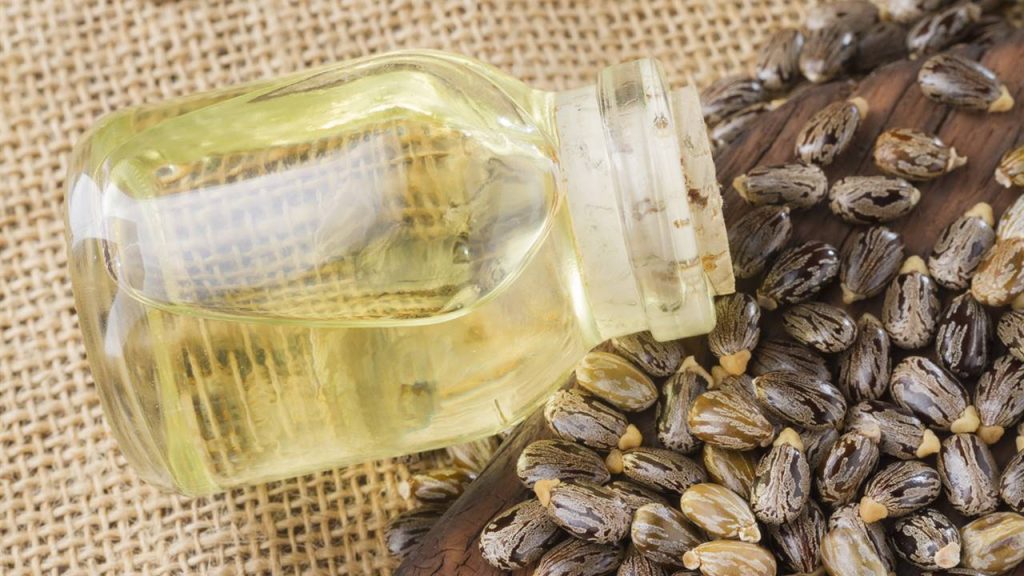Castor oil is a very popular natural remedy for skin care and constipation. Discover all its properties and uses.

- What is castor oil?
- Properties of castor oil
- What is castor oil for?
Castor oil is a vegetable oil that has long been used as a natural treatment for various health problems, especially to relieve constipation and care for skin and hair. But it has many other properties and possible uses.
WHAT IS CASTOR OIL?
Castor oil is extracted from castor seeds (Ricinus communis) which is grown mainly in Africa, South America and India. The main producing countries of this oil are Brazil, China and India.
Its use as a natural remedy for various indications (from skin care to constipation) dates back thousands of years. Today, it is used in countless cosmetic products (soaps, creams, shampoos and hair softeners …) and you can often find it with its English name: castor oil. It is also used in medicines, in food (as an additive, flavoring or preservative) and has many other industrial uses: it is found in paints, dyes, lubricants, cold-resistant plastics, etc.
Castor seeds contain a toxic protein, known as ricin, which means that they should never be consumed directly. However, the heating process they undergo to make castor oil deactivates ricin, allowing it to be used safely.
PROPERTIES OF CASTOR OIL
Castor oil has multiple health benefits, including:
- It is anti-inflammatory.
- It has laxative effect.
- It is antioxidant.
- Antimicrobial
- Antifungal.
- Analgesic.
- Moisturizing.
- It stimulates the formation of collagen and strengthens the structure of tendons.
WHAT IS CASTOR OIL FOR?
Castor oil has been used since ancient Egypt to combat constipation, as it increases muscle contractions that push stool through the intestines. However, the recommended dose should not be exceeded because it could cause the opposite effect and cause frequent bowel movements, cramping, diarrhea and bloody stools.
It has also been used in traditional medicine to induce labor, as it is believed to help dilate the cervix. However, and despite the fact that several studies indicate that it is effective and safe, some doctors advise against it because it can have side effects (nausea, vomiting, diarrhea …) and could increase the chances that the baby eliminates meconium (his first bowel movement) before birth and this would increase the risk of meconium aspiration and, consequently, of neonatal respiratory problems.
Topically it can be used to:
- Reduce inflammation, for example in carpal tunnel syndrome or plantar fasciitis. In Ayurvedic medicine it is also used to improve arthritis pain.
- Take care of the eyebrows and eyelashes, thanks to its moisturizing properties. It is believed that its use can help grow hair, eyebrows and eyelashes.
- Remove brown spots on the skin of the face, hands and décolleté (lentigines): apply twice a day giving a gentle massage until absorbed. It can also be mixed with baking soda and applied every night.
- Take care of dry hair and eliminate dandruff. In addition, its lubricating properties bring shine to the hair and prevent split ends.
- Reduce pimples and pimples, thanks to its antimicrobial and anti-inflammatory properties.
- Keep skin hydrated: Acts as a moisturizer that traps moisture and helps keep skin soft, smooth and hydrated. It can also help speed up wound healing.
- On the other hand, thanks to its antimicrobial and antifungal properties, it can be effective (in a 10% solution) to clean dentures and eliminate oral bacteria and fungi.
- Although it is usually considered safe for topical use, it can cause an allergic reaction in some people, with redness, swelling, itching, or rash. That is why it is advisable to test it first in a small area to see how the body reacts. Similarly, it can cause allergy when ingested.






